Music: reading and vocabulary
文档属性
| 名称 | Music: reading and vocabulary |  | |
| 格式 | rar | ||
| 文件大小 | 1.5MB | ||
| 资源类型 | 教案 | ||
| 版本资源 | 外研版 | ||
| 科目 | 英语 | ||
| 更新时间 | 2008-02-16 20:43:00 | ||
图片预览

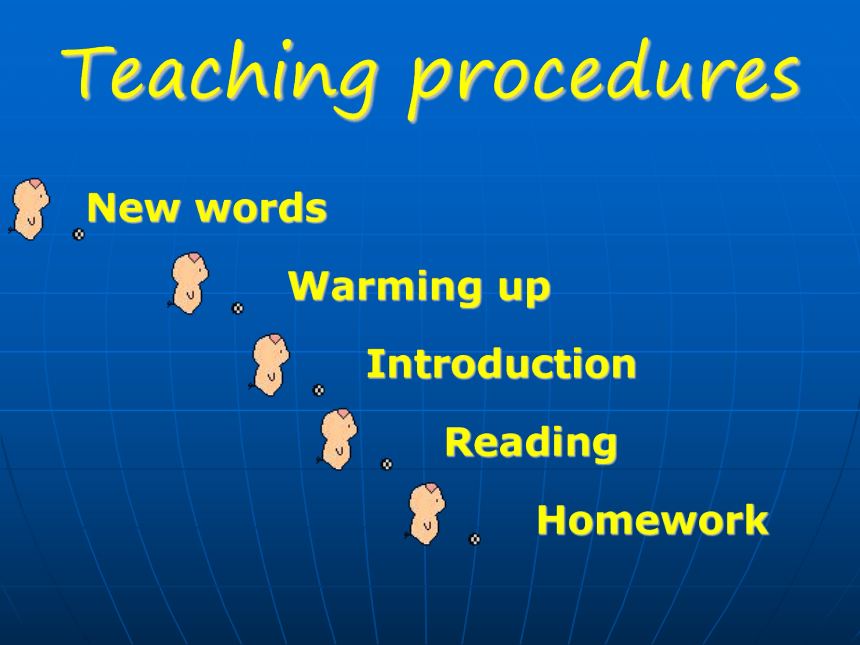
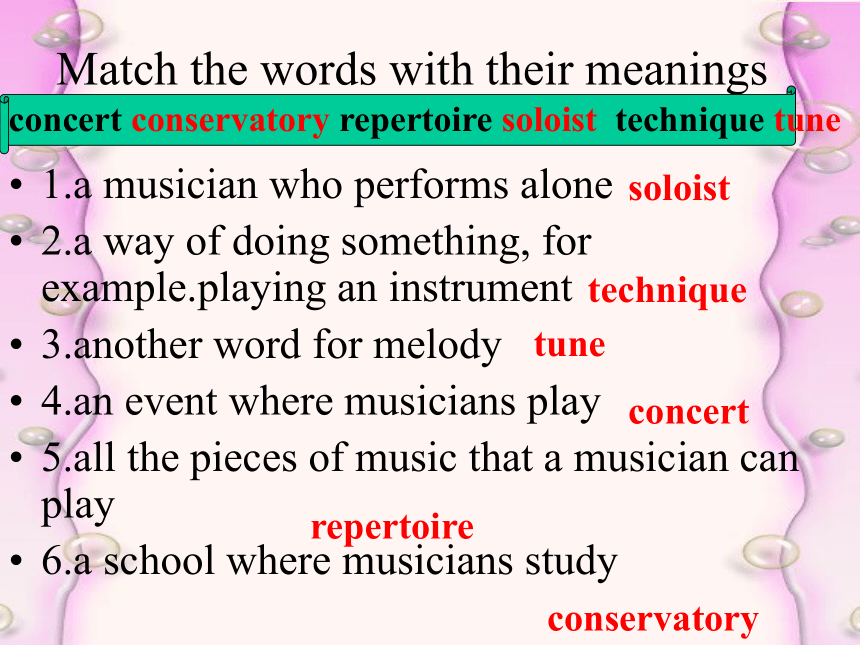
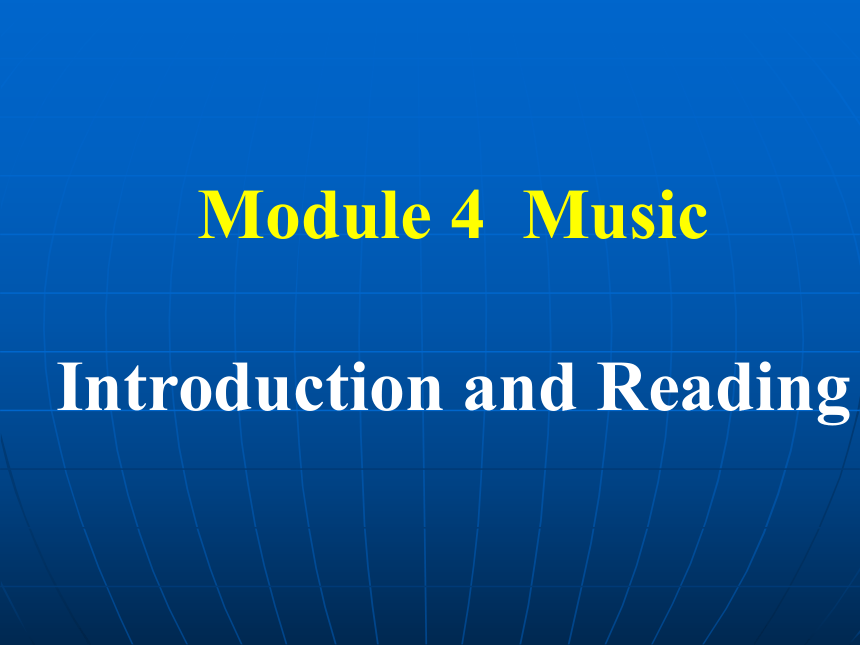
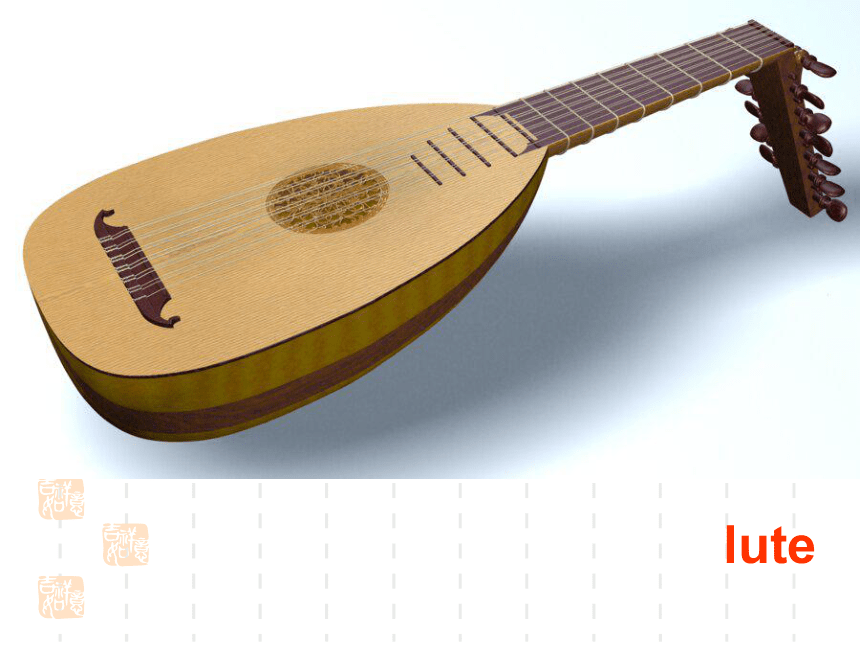
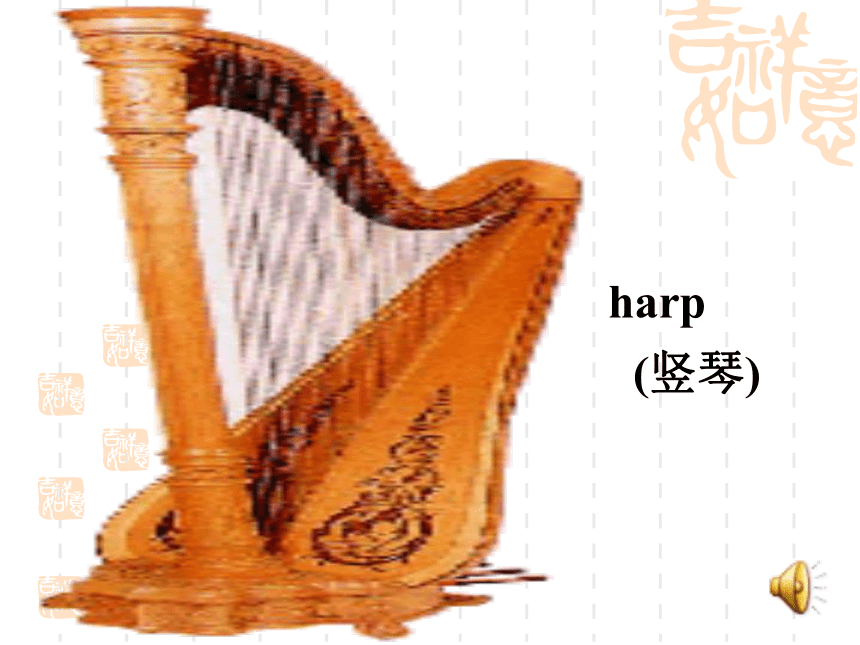
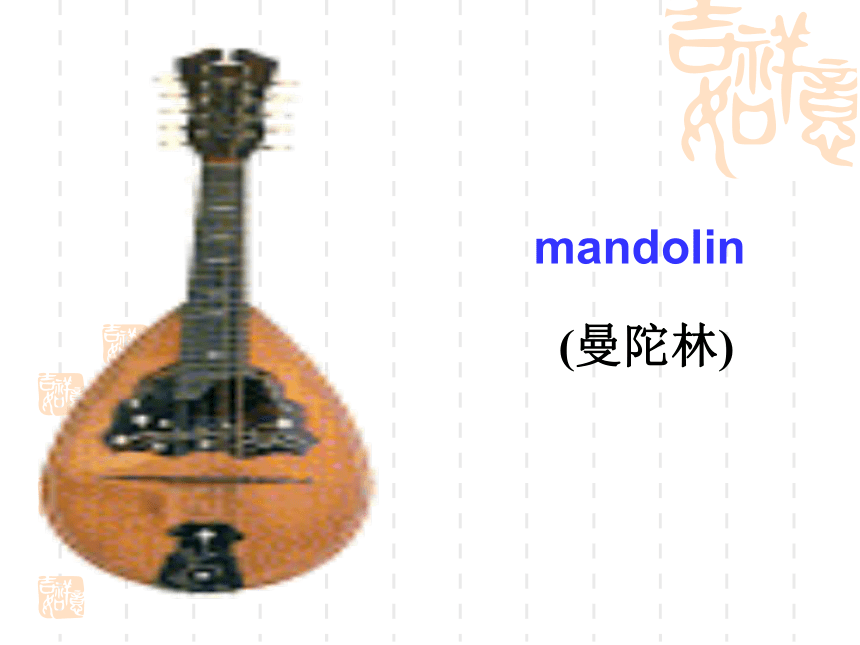
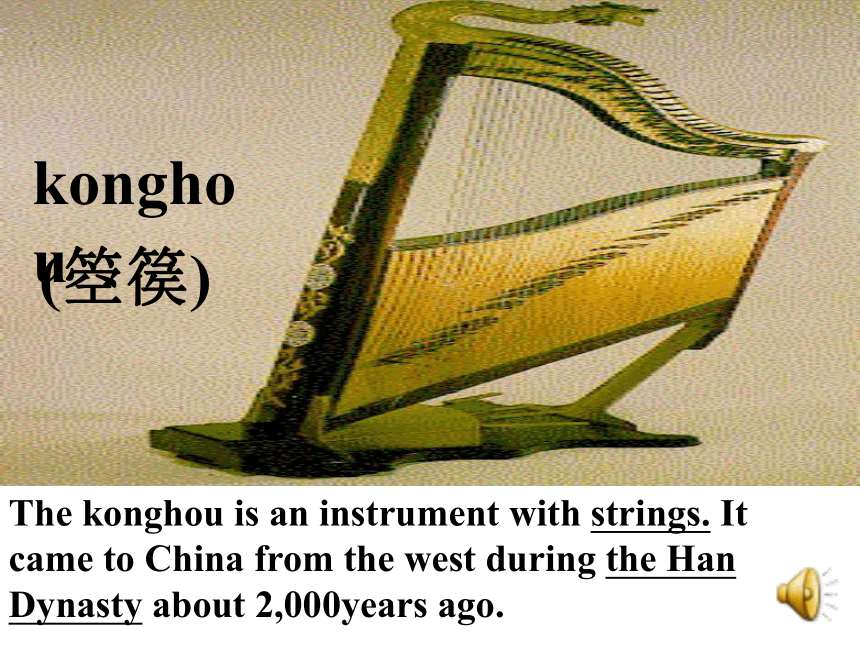
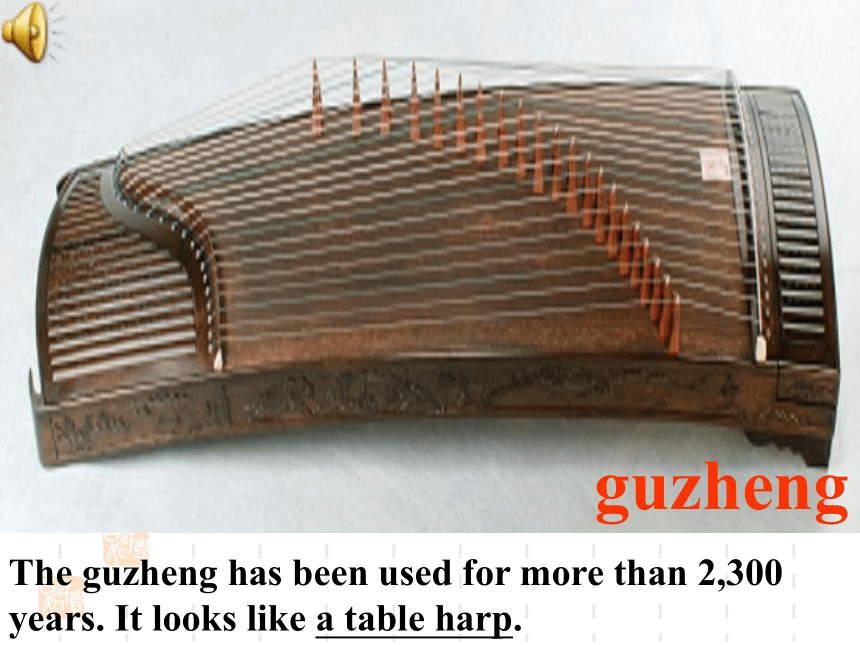
文档简介
课件29张PPT。Welcome! New words
Warming up
Introduction
Reading
Homework
Teaching procedures Match the words with their meanings1.a musician who performs alone
2.a way of doing something, for example.playing an instrument
3.another word for melody
4.an event where musicians play
5.all the pieces of music that a musician can play
6.a school where musicians studyconcert conservatory repertoire soloist technique tunesoloisttechniquetuneconcertrepertoireconservatoryModule 4 Music
Introduction and Readingluteharp(竖琴)mandolin(曼陀林)konghou(箜篌)The konghou is an instrument with strings. It came to China from the west during the Han Dynasty about 2,000years ago.guzhengThe guzheng has been used for more than 2,300
years. It looks like a table harp.pipaThe pipa is a lute
with four strings
and is a relative of
the European lute.yueqin(月琴)The yueqin is a round
instrument like a mandolin.
It was called qinpipa
(琴琵琶) during
the Han Dynasty.
Western musical instrumentsharplutemandolinChinese musical instrumentsyueqinkonghouguzhengpipaPractice2. Do you know any artists who play them?1.Do you know any Chinese classical
pieces which feature these instruments?Watch and guess:who is she?现居加拿大蒙特利尔市(Montreal)的刘芳1974年生于云南昆明,六岁开始学习琵琶,九岁时首次公演,并开始在各种青少年琵琶比赛中不断获奖,同时也多次参加同各种文艺团体合作的演出活动,被喻为“在鲜花和掌声中长大”。1985年,英国女王伊丽莎白访问中国时,十一岁的刘芳曾为女王陛下演奏琵琶。刘芳多次获得云南省少年乐器比赛一等奖,并于1988年获全国青少年民族器乐比赛二等奖(琵琶组一等奖)。一年后考入上海音乐学院民乐系,学习琵琶和古筝。1993年自上海音乐学院毕业后回到昆明,在市歌舞团担任独奏演员。1996年移居加拿大以来,刘芳每年定期在欧洲国家巡回演出,活跃于欧美的音乐舞台上,并参加各种艺术节,每年举行近百场音乐会,包括个人独奏及与其他音乐家和乐队合作,得到了专家和听众极高的赞誉。Personal Introduction “简直无法用语言来形容刘芳在巴黎的琵琶
古筝独奏音乐——那是对于关注艺术并且博
学的上层公众在听觉、视觉和心灵上的一场
真正盛宴。对于如此出色的演奏家来讲,她
能让人遗忘高难度的技巧障碍,把听众轻松
而宁静地带入美妙的音乐天堂。刘芳高超的
演技同她的音乐理念结合,用手指,用整个
身心,用优雅的姿态演奏中国音乐中的大师
作品,将自己完全融入音乐之中。”
Liu Fang’s guzheng performanceLiu Fang’s pipa performanceReading and vocabulary
An interview
with Liu Fang
( 刘芳访谈录)
musicianWork in pairs : Fill in the blank1974KunmingCanadaPipa,yueqin,
guzhengRead Part 1 of the passage and explain the references:1…during her visit to China.Who visited China?
2.she taught me to play the yueqin.Who taught her to play?
3.I have been living there since then.Where has she been living?
4…each one has its special way of interpreting the classical pieces.Each what?
5.The same is true of my second instrument.What is true about the second instrument?Her motherThe Queen of English
CanadaPipa schoolTo respect traditions but add her own style when playingRead Part 2 of the passage and choose the correct answers:1.Traditional singing is
a.the most important influence on Liu Fang’s style
b.not such an important influence.
2.When people listen to her playing
a.they also hear her singing
b.they think they can hear singing
3.Liu Fang thinks that
a.Chinese music is like the Chinese language
b. Chinese music and language use the same tones
4.Chinese classical pieces often have poetic titles,
a.which is understandable
b.which is very surprising
5.Empty spaces in Chinese paintings
a.are like the silent parts of Chinese music
b.mean the pictures have no lifeRead Part 3 of the passage and the questions:
1.What does Liu Fang enjoy about performing?
2.What makes her feel depressed or lonely?
3.What does she want to do with other musicians?
4.What is her ambition regarding Chinese music?The atmosphere in a concert hall.When she has no concert for a long time.Work with them.She wants to compose her own music and introduce classical pipa,guzheng music everywhere.Work in groups of four:
1. What’s Part 1 mainly about?
2. What’s the main idea of Part 2?
3. And what about Part 3 ?
Part 1 introduces Liu Fang and her musical background.Part 2 tells about Liu Fang’s musical influences
and characteristics of Chinese classical music.Part 3 is about Liu Fang’s love for performing live and her goals as an artist.HomeworkFinish the workbook exercises.
Go over the passage .Thank you
Warming up
Introduction
Reading
Homework
Teaching procedures Match the words with their meanings1.a musician who performs alone
2.a way of doing something, for example.playing an instrument
3.another word for melody
4.an event where musicians play
5.all the pieces of music that a musician can play
6.a school where musicians studyconcert conservatory repertoire soloist technique tunesoloisttechniquetuneconcertrepertoireconservatoryModule 4 Music
Introduction and Readingluteharp(竖琴)mandolin(曼陀林)konghou(箜篌)The konghou is an instrument with strings. It came to China from the west during the Han Dynasty about 2,000years ago.guzhengThe guzheng has been used for more than 2,300
years. It looks like a table harp.pipaThe pipa is a lute
with four strings
and is a relative of
the European lute.yueqin(月琴)The yueqin is a round
instrument like a mandolin.
It was called qinpipa
(琴琵琶) during
the Han Dynasty.
Western musical instrumentsharplutemandolinChinese musical instrumentsyueqinkonghouguzhengpipaPractice2. Do you know any artists who play them?1.Do you know any Chinese classical
pieces which feature these instruments?Watch and guess:who is she?现居加拿大蒙特利尔市(Montreal)的刘芳1974年生于云南昆明,六岁开始学习琵琶,九岁时首次公演,并开始在各种青少年琵琶比赛中不断获奖,同时也多次参加同各种文艺团体合作的演出活动,被喻为“在鲜花和掌声中长大”。1985年,英国女王伊丽莎白访问中国时,十一岁的刘芳曾为女王陛下演奏琵琶。刘芳多次获得云南省少年乐器比赛一等奖,并于1988年获全国青少年民族器乐比赛二等奖(琵琶组一等奖)。一年后考入上海音乐学院民乐系,学习琵琶和古筝。1993年自上海音乐学院毕业后回到昆明,在市歌舞团担任独奏演员。1996年移居加拿大以来,刘芳每年定期在欧洲国家巡回演出,活跃于欧美的音乐舞台上,并参加各种艺术节,每年举行近百场音乐会,包括个人独奏及与其他音乐家和乐队合作,得到了专家和听众极高的赞誉。Personal Introduction “简直无法用语言来形容刘芳在巴黎的琵琶
古筝独奏音乐——那是对于关注艺术并且博
学的上层公众在听觉、视觉和心灵上的一场
真正盛宴。对于如此出色的演奏家来讲,她
能让人遗忘高难度的技巧障碍,把听众轻松
而宁静地带入美妙的音乐天堂。刘芳高超的
演技同她的音乐理念结合,用手指,用整个
身心,用优雅的姿态演奏中国音乐中的大师
作品,将自己完全融入音乐之中。”
Liu Fang’s guzheng performanceLiu Fang’s pipa performanceReading and vocabulary
An interview
with Liu Fang
( 刘芳访谈录)
musicianWork in pairs : Fill in the blank1974KunmingCanadaPipa,yueqin,
guzhengRead Part 1 of the passage and explain the references:1…during her visit to China.Who visited China?
2.she taught me to play the yueqin.Who taught her to play?
3.I have been living there since then.Where has she been living?
4…each one has its special way of interpreting the classical pieces.Each what?
5.The same is true of my second instrument.What is true about the second instrument?Her motherThe Queen of English
CanadaPipa schoolTo respect traditions but add her own style when playingRead Part 2 of the passage and choose the correct answers:1.Traditional singing is
a.the most important influence on Liu Fang’s style
b.not such an important influence.
2.When people listen to her playing
a.they also hear her singing
b.they think they can hear singing
3.Liu Fang thinks that
a.Chinese music is like the Chinese language
b. Chinese music and language use the same tones
4.Chinese classical pieces often have poetic titles,
a.which is understandable
b.which is very surprising
5.Empty spaces in Chinese paintings
a.are like the silent parts of Chinese music
b.mean the pictures have no lifeRead Part 3 of the passage and the questions:
1.What does Liu Fang enjoy about performing?
2.What makes her feel depressed or lonely?
3.What does she want to do with other musicians?
4.What is her ambition regarding Chinese music?The atmosphere in a concert hall.When she has no concert for a long time.Work with them.She wants to compose her own music and introduce classical pipa,guzheng music everywhere.Work in groups of four:
1. What’s Part 1 mainly about?
2. What’s the main idea of Part 2?
3. And what about Part 3 ?
Part 1 introduces Liu Fang and her musical background.Part 2 tells about Liu Fang’s musical influences
and characteristics of Chinese classical music.Part 3 is about Liu Fang’s love for performing live and her goals as an artist.HomeworkFinish the workbook exercises.
Go over the passage .Thank you
